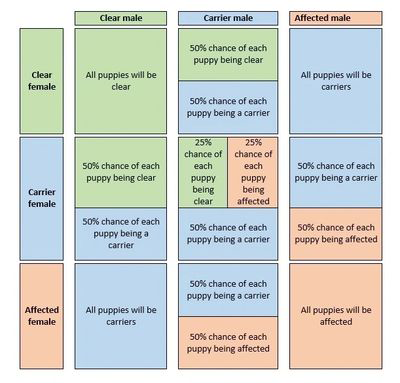
Why Is It Important That We DNA Test Our Breeding Dogs?
We want to avoid producing puppies affected with known genetic conditions. Many diseases now have genetic markers that reveal if your puppy will develop a genetic problem. We use Embark for breeders who test for 255 health risks.
How Are Results Recorded?
The results have markings as "clear," "carrier," or "affected."
- Clear - These dogs tested negative for any copies of the abnormal gene associated with the test condition. These dogs are highly unlikely to develop this condition and will pass on a standard copy of the gene to their puppies.
- Carrier - These dogs have one copy of the normal gene and one copy of the abnormal gene associated with the test condition. These dogs are highly unlikely to develop this condition and may pass either one copy of the normal gene or one copy of the abnormal gene onto their puppies.
- Affected - These dogs have two copies of the abnormal gene associated with the test condition. These dogs will likely be affected by the disorder and will pass on one copy of the abnormal gene to any future puppies.
We take this very seriously and will never breed puppies affected by any test condition.
Breed-Relevant Results
Embark's Research indicates that out of the 255 genetic markers tested, the 11 genetic diseases listed below are more relevant to Golden Retrievers and may influence their chances of developing certain health conditions.
1: Congenital Myasthenic Syndrome, CMS
What Is Csm?
CSM is a non-progressive disease characterized by episodes of exercise intolerance and weakness.


2: Degenerative Myelopathy, DM
What Is DM?
The dog equivalent of Amyotrophic Lateral Sclerosis, or Lou Gehrig's disease, DM is a progressive degenerative disorder of the spinal cord. Because the nerves that control the hind limbs are the first to degenerate, the most common clinical signs are back muscle wasting and gait abnormalities.
3: Dystrophic Epidermolysis Bullosa
What Is Dystrophic Epidermolysis Bullosa?
This condition arises from a mutation in Collagen Type VII. Collagens of all types anchor the layers of our skin together: they give skin its springy, youthful texture (and thus are a significant component of anti-wrinkle creams). Collagen Type VII has the specific job of connecting the epidermis, the surface layer of the skin, to the underlying tissues, leading to dogs with especially stretchy skin detached from the underlying tissues.
4: Golden Retriever Progressive Retinal Atrophy 1, Gr-PRA1
What Is Gr-PRA1?
Retriever PRA 1 is a retinal disease that causes progressive, non-painful vision loss. The retina contains cells, called photoreceptors, that collect information about light and send signals to the brain. There are two types of photoreceptors: rods for night vision and movement and cones for day vision and color. This type of PRA leads to early loss of rod cells, leading to night blindness before day blindness.
5: Golden Retriever Progressive Retinal Atrophy 2, Gr-PRA2
What Is Gr-PRA2?
Golden Retriever PRA 2 is a retinal disease that causes progressive, non-painful vision loss. The retina contains cells, called photoreceptors, that collect information about light and send signals to the brain. There are two types of photoreceptors: rods for night vision and movement and cones for day vision and color. This type of PRA leads to early loss of rod cells, leading to night blindness before day blindness.


6: Ichthyosis, ICH1
What Is Ichthyosis, ICH1?
This skin disorder gets its name from the thick, darkly pigmented scales of skin ("ichthys" is Greek for "fish") that affected dogs display over most areas of the body, not including the head or extremities.
7: Muscular Dystrophy
What Is Muscular Dystrophy?
The DMD gene produces the protein dystrophin. Dogs affected with MD have abnormally low levels of functional dystrophin, leading to muscle fiber damage, progressive muscle wasting, and weakness.
8: Neuronal Ceroid Lipofuscinosis 5, Ncl 5
What Is Ncl 5?
A lysosome is a structure within the cell that digests and removes waste. When the lysosome cannot recycle waste properly, it accumulates and causes the cell to die. This form of lysosomal storage disease causes juvenile to adult-onset neurologic signs.
9: Osteogenesis Imperfecta
What Is Oi?
Our bones are rigid and flexible, capable of withstanding high impact and constant tension from attached muscle tendons and ligaments. OI has caused dogs to lose the flexible part of the bone, primarily composed of Type I collagen, which leads to highly brittle bones and teeth. Type I collagen is also essential in joints; affected dogs can also present with hyperflexible joints and joint pain.


10: Progressive Retinal Atrophy, Pra-Prcd
What is PRA-prcd?
PRA-prcd is a retinal disease that causes progressive, non-painful vision loss. The retina contains cells, called photoreceptors, that collect information about light and send signals to the brain. There are two types of photoreceptors: rods for night vision and movement and cones for day vision and color. This type of PRA leads to early loss of rod cells, leading to night blindness before day blindness.
11: Retina Dysplasia and Optic Nerve Hypoplasia
What Are Retina Dysplasia and Optic Nerve Hypoplasia?
This variant may cause changes to several tissues of one or both eyes, including the complete failure of the tissue to develop, underdevelopment, abnormal growth, or improper function.
Our friendly team is here to answer any questions about genetic testing in our breeding dogs. Call us at 407-474-5574 today.






